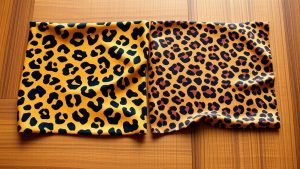
Leopard wood stands out for its striking reddish-brown hue and distinctive leopard spot pattern, created by its pronounced figure when quartersawn. Its large flecks, wide medullary rays, and coarse texture add visual appeal. Highly durable, it resists decay and infestation, ensuring longevity without the need for chemical preservatives. While it's ideal for high-quality furniture and instruments, working with it requires specialized tools due to its hardness. There's much more to uncover about its characteristics and applications.
When you explore the world of exotic hardwoods, Leopard Wood stands out for its striking appearance and exceptional qualities. Its medium to dark reddish-brown color, coupled with grey or light brown rays that resemble leopard spots, captivates anyone who encounters it. This unique coloration and pattern arise from the pronounced figure that emerges when the wood is quartersawn, revealing large flecks attributable to its wide medullary rays. The fairly coarse texture and straight grain further enhance its visual appeal, making it a sought-after material for various applications.
Originating from South America, Central America, Chile, and Brazil, Leopard Wood, scientifically classified as Roupala spp., is available in international markets. Its commercial distribution is facilitated by specialized wood suppliers, ensuring you can find it for your projects. What's particularly notable is its environmental status; it isn't listed in CITES Appendices or the IUCN Red List of Threatened Species, which makes it a more sustainable choice compared to other exotic woods.
When it comes to uses, Leopard Wood excels in the production of high-quality furniture and cabinetry, serving as an ideal choice for paneling and interior decorations. Its density and durability make it suitable for crafting musical instruments, such as guitars, while its striking patterns lend themselves well to veneer production. If you're interested in turned objects, you'll appreciate how this hardwood's density and stability cater to those needs. Additionally, its very high durability ensures that it can withstand the test of time, making it an exceptional choice for long-lasting projects.
One of Leopard Wood's most remarkable qualities is its durability. Naturally resistant to decay and infestation, it offers excellent structural integrity due to its tightly interlocked grain. Unlike many other woods, it doesn't require chemical preservatives, which simplifies maintenance. However, its high density can pose challenges during fabrication. You'll need to be cautious of potential tearout problems when planing, as its uneven texture can complicate the process.
The aesthetic appeal of Leopard Wood can't be overstated. The dramatic flecking, resembling leopard spots, provides a unique visual impact that elevates any design. The combination of reddish-brown tones with dark streaks adds a luxurious touch, transforming spaces into conversation pieces. This wood's distinctive patterns allow for creative designs that stand out, making it a favorite among interior decorators and furniture makers alike.
Despite its many advantages, working with Leopard Wood requires specialized tools and skilled craftsmanship. Its hardness and density demand careful handling and technique to achieve ideal results. While it glues and finishes well, you'll need to be mindful of its difficulty when cutting and machining. These factors make it essential to approach projects involving Leopard Wood with the right tools and expertise.
In terms of cost, Leopard Wood generally falls into the medium to high price range for imported woods. However, its unique appearance and durability justify the investment. If you're willing to navigate the challenges of working with this exceptional hardwood, you'll find that the rewards far outweigh the difficulties, making Leopard Wood a unique choice for your next project.
Conclusion
Ultimately, you might think that leopard wood's striking appearance is its most remarkable feature, but it's actually the complexity of its grain patterns that sets it apart in woodworking. Ironically, while many seek its vibrant aesthetics, the true artistry lies in how those unique markings can challenge craftsmen. So, as you admire its beauty, remember that the real value of leopard wood isn't just skin deep; it's in the skill required to bring its character to life.



